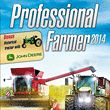Professional Farmer 2014: Field works at a larger scale
Expansion of the farm
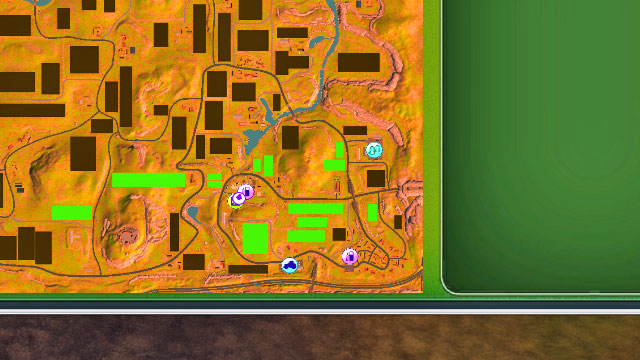
To expand your business, you need more land. Eventually, during a dozen-or-so years of playing, you should be able to buy fields all around. Remember, that the price for 1 ha of field is, around, 10 000 Euros. So, regardless of which field you buy (a smaller or a bigger one) the price per are is always the same. You should also take into consideration the fact that it is best to buy fields in the late Summer, when something is sown on it and ready to harvest. This means additional profit.
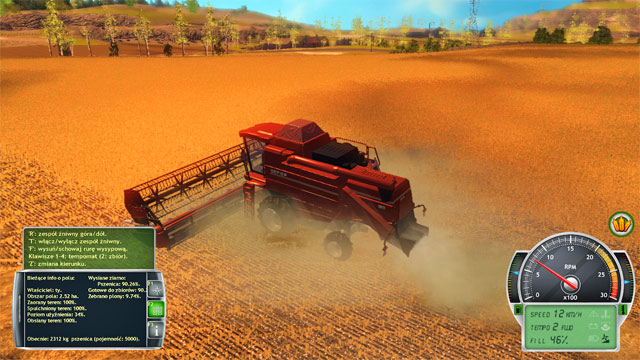
Initially, from the 4-5 fields that you already have, try to save up for the big field located to the South of the farm. It is a field of the area of, around, 2,5 ha which costs 25 000 Euros. It is very profitable to on it, due to its proximity. Try to buy the bigger fields. There is really no point in bringing the equipment to the smaller ones - it is time consuming. An exception are the small fields located close to each other, which you treat as if they were a whole.
Vehicles and machinery replacement
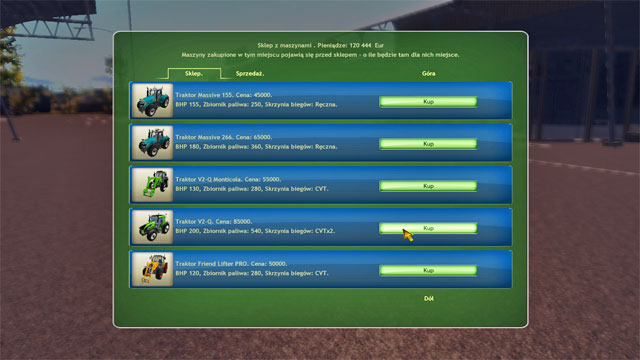
Buying more fields is connected with the fact that the equipment that you have is incapable of doing all the work within comparable time. The growth of acreage must be followed by replacing all of the machines and tools, but it is entirely up to you if you replace them step by step, or whether it is better to save up for the best available equipment. You should have replaced the plow a long time ago, which has been mentioned in the guide. You also should own a cultivator that is wider than the initial one. In your garage, there should be one tractor with automatic transmission- the V2-Q for 85 000 Euros seems to be the best choice.
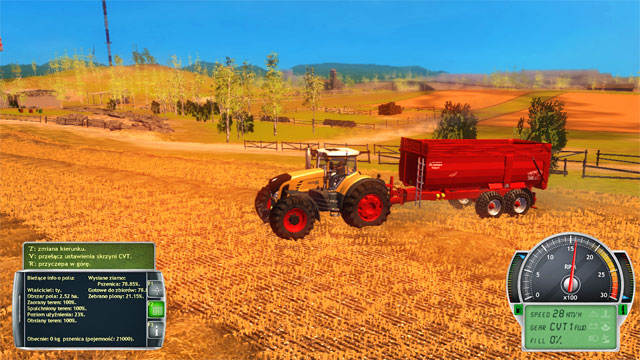
A bit further into the game, it is also worthwhile to turn your attention to the Friend 4990 tractor for 125 000 Euros. It is a bit bigger and more powerful - ideal for big machines or trailers.
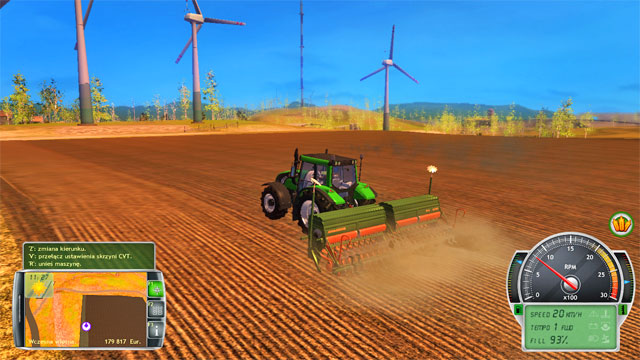
There are two seed drill models available in the game. The Amazone D9 4000 special that you already have, can be sold for 11 250 Euros. A new one, Amazone D9 60 special, can be bought for 40 000 Euros. This means that, in fact, replacing the seed drill with a better model with the working width greater by a half), is going to cost you less than 30 000 Euros. Before you sell the seed drill empty it of any seeds, at the warehouse - it would be too bad if it went to waste. Replacing this piece of equipment will make the seeding process considerably faster.
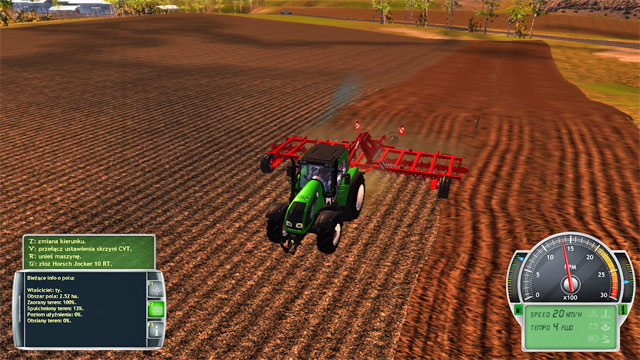
Another tool that you need to replace is the cultivator. It is no surprise that to have a machine with a greater working width, you need to invest, at least, 40 000 Euros. Do not get too particular here and try to earn 50 000 Euros, for which you will by the cultivator of the greatest working width -HorschJocker 10 RT. You need to keep in mind that, although the V2-Q tractor will be able to handle it, it is going to be rather difficult to use it.

Another tool that you can replace is the broadcast spreader. The sprayer that you have now, can be sold for 22 500 Euros. A new one is, as much as, 60 000 Euros. Therefore, the replacement of the sprayer is going to cost you almost 40 000 Euros.
If you currently are tied up with some other investments, you should, probably, skip this one. The working width of a bigger sprayer is a bit greater and the process of fertilizing the field is a short-lasting one, in comparison with the other processes (you can drive across the field very fast, the width of the sprayer that you already own, is considerable, if compared with the other pieces of equipment). This is why you should leave replacing the sprayer for the very end.

The thing with harvesters is a more complex and more costly one. If you are not going to sow corn (which is equally profitable as wheat or soybeans), you can keep with the Defier 180 harvester that you get in the career mode. It is only a good idea to buy the widest harvesting assembly for it, which is 12,2 meters wide. You can also buy a better model of the same brand (its grain tank is bigger). In the future, for harvesting all types of crops - apart from corn - when you can already afford it- it is a good idea to buy the Charles Appaloosa 240. It is the most powerful, has the largest grain tank, a wide harvesting assembly (12,2 m), good maneuverability and acceleration. It costs 250 000 Euros.

If you are going to grow corn, you need to buy the Massive harvester, the highest Massive A75 model would be best. Corn after it is sown, requires a special harvesting assembly, and only this make of the harvesters has the widest attachment for harvesting this plant.
remember: regardless of your harvester model always buy the widest harvesting assembly available. This will save up a whole lot of time.
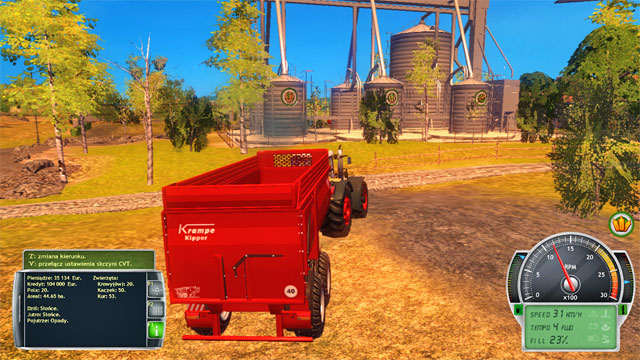
You should also remember to replace trailers - the basic one has the carrying capacity of, only,14 000 kg. The KrampeBigBody 650 for 22 000 Euros is the optimal choice - its capacity is 21 000 kg.
Baling and selling of straw
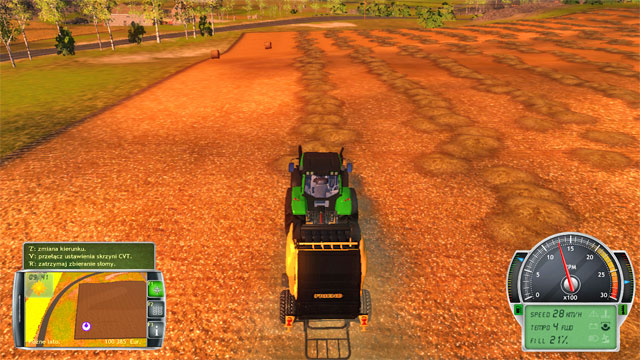
As an additional source of income, you can perceive baling of the reaped straw and selling it. After you harvest the crops, what remains is swaths of straw. Bale it, using the baling press that you have had from the very beginning.
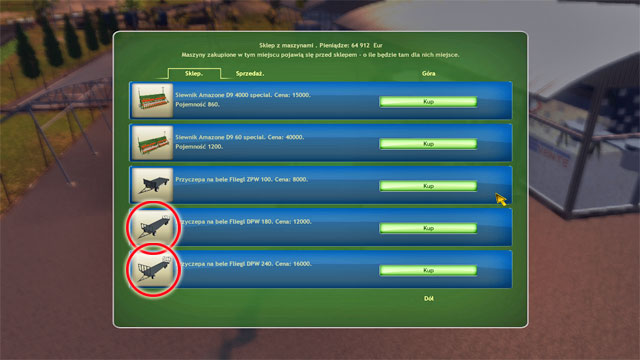
To sell bales, you first need to load them up on the trailer and carry it to the collection point. For that, you need a tractor forklift and a trailer for bales. Buy the tractor Friend Lifter PRO for 50 000 Euros. Additionally, buy the Fliegl DPW 180 trailer for bales, for 12 000 Euros or the Fliegl DPW 240 trailer for bales, for 16 000 Euros. There is no point in buying the smallest trailer.
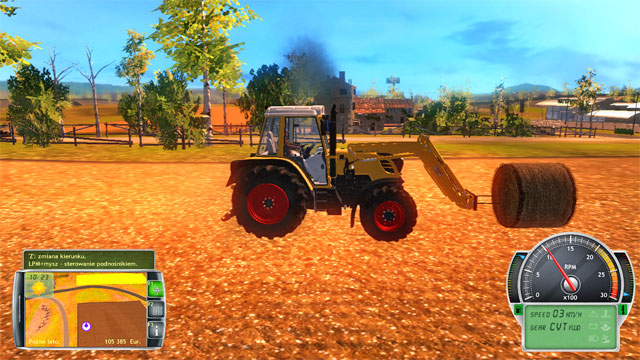
Drive up to the bale and impale it with the forklift tractor- aim below the bale's center. Lift the bale afterwards (you control the fork by holding down the [right mouse button] and [moving the mouse]). Drive up to the trailer for bales that you have prepared earlier.

Position the bale above the trailer and lower the fork a bit (in a way that makes the bale touch to the bottom of the trailer). Try to reverse with the tractor so that the bale remains on the trailer. Unfortunately, this task is not easy because the game's physics is far from perfect. In this way, load the bales onto the trailer. Try to load them tightly side by side, until the trailer is full - the point is that you need to prevent the bales from rolling back and forth, during the ride.
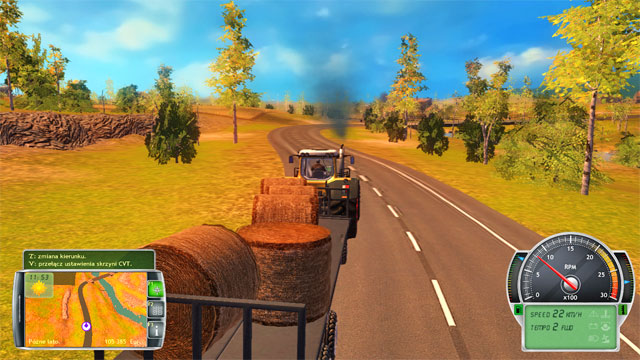
Go North now, into the straw bales collection point. Unfortunately, you need to do that slowly, which decreases the risk of one of the bales' falling off the trailer over bumps. You should be especially careful while taking turns on elevations and slopes.
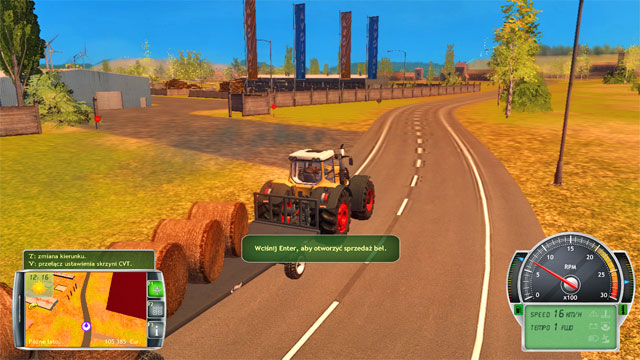
You should also watch out for the other vehicles. Unfortunately, the way there leads over dirt road at some point. This is where you should be especially careful. It is enough that you drive up to the gates of the straw collection point.
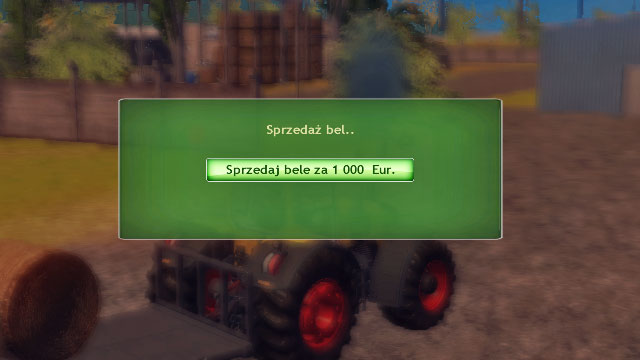
By pressing [Enter] you access a simple sale screen. For each straw bale that you deliver, you receive 200 Euros. Is it worth it? If you take necessary investments into consideration, e.g. 62 000 Euros, it is not that profitable. To make the investment into the trailer and the forklift pay off, you would have to deliver more than 200 bales so, you would have to take the journey several tens of times.
Effectiveness of cultivation
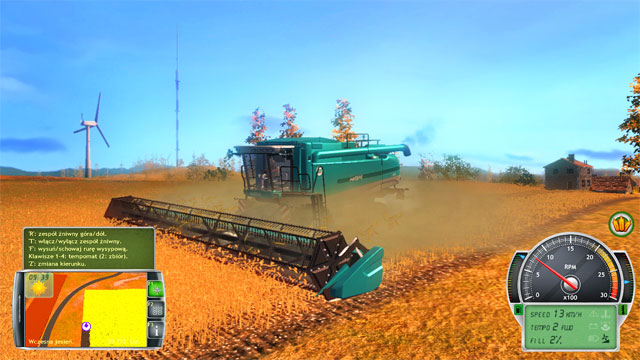
Remember always to perform all of the actions, i.e. plowing, loosening, sowing and fertilizing. If you skip plowing (i.e. start your works with loosening) this will result in a 50% loss of crops (if you still perform the rest of the steps). If you do not loosen (if, after plowing you start sowing), this results in a loss of, around 33% of crops. If, however, after you sow, you skip fertilization, this will result in a drop in crops by, around, 15%. Therefore, it is worthwhile to perform all the steps.
The long and arduous playing will finally bring profits but, it is worthwhile to analyze the situation and cultivate only the most profitable crops. Although you sow the same amount of seeds, the amount of crops that you harvest varies. The most profitable are: wheat, corn and soybeans.
The average harvested amount (in kg) obtained from fields larger than . 1 ha.:
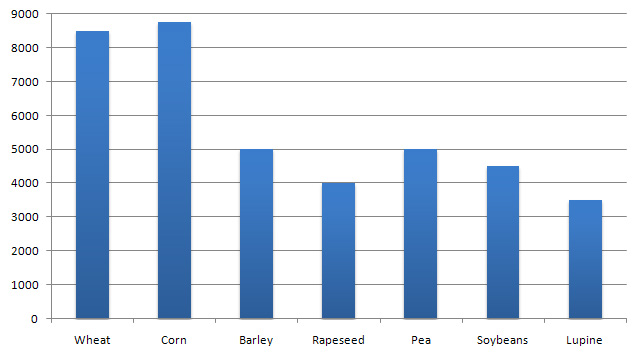
Plant name | Average harvest (in kg) collected from fields larger than 1 ha |
Wheat | 8500 |
Corn | 8750 |
Barley | 5000 |
Rapeseed | 4000 |
Pea | 5000 |
Soybeans | 4500 |
Lupine | 3500 |
With the assumption that the soil is plowed, loosened, seeded and finally fertilized, from a field of the acreage of 1 ha, under the same conditions, he most crops can be received from wheat and corn. The least can be received from lupine which functions in the game as a rotation crop, and not a way to make money. The key matter, however, is how much money you will receive at the collection point.
Average income (in Euros) received from the sale of crops from fields larger than 1 ha.:
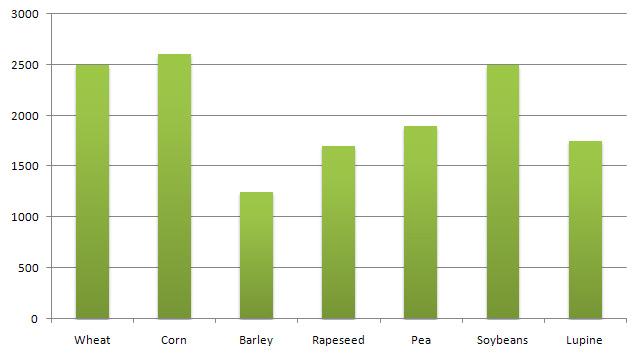
Name | Average harvest from acreage above 1 ha | Average price per kg at the collection point | Average income from sale |
Wheat | 8500 kg | 0,29 Euros | 2 500 Euros |
Corn | 8750 kg | 0,30 Euros | 2 600 Euros |
Barley | 5000 kg | 0,25 Euros | 1 250 Euros |
Rapeseed | 4000 kg | 0,42 Euros | 1 700 Euros |
Pea | 5000 kg | 0,38 Euros | 1 900 Euros |
Soybeans | 4500 kg | 0,55 Euros | 2 500 Euros |
Lupine | 3500 kg | 0,50 Euros | 1 750 Euros |
As you can see, which has been stated above, what is most profitable, is the cultivation of wheat, soybeans and corn. In the case of corn although the income from the sale may be a little higher, you need to take into consideration the fact that the widest harvesting assembly for corn is narrower than the harvesting assemblies for the other crops. That is why, you earn the most from selling corn but harvesting it takes a bit longer .You should also remember that the presented price for the crops is an average and that, in general, the prices on crops fluctuate: give or take 3-4 Eurocents per kg! Unfortunately, the current price for crops, at the collection point, is not displayed anywhere.
Finally, costs also are worth mentioning. In the case of all plants, the costs include fuel and fertilizers - these costs are the same for all kinds of the cultivated plants. With corn, you should also include the cost of buying a special harvesting assembly What sets these plants apart is the cost of sowing - the cost of 100 kg of seeds for each is different. To seed 1 ha of field, you need (in the case of each plant) 450 kg of seeds.
The cost (in Euros) of seeds required to seed a field of the acreage larger than 1 ha.:
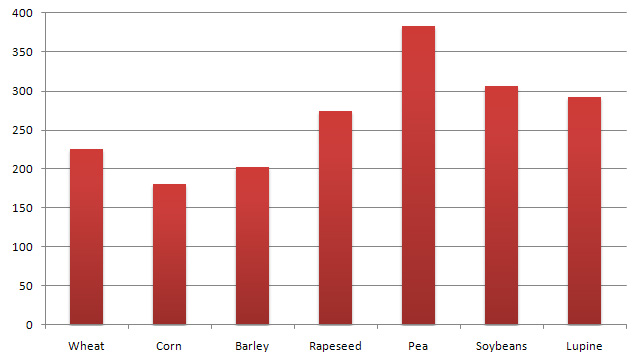
Seed type | Price for 100 kg of seeds | Cost of sowing1 ha |
Wheat | 50 Euros | ab. 225 Euros |
Corn | 40 Euros | ab. 180 Euros |
Barley | 45 Euros | ab. 203 Euros |
Rapeseed | 61 Euros | ab. 275 Euros |
Pea | 85 Euros | ab. 373 Euros |
Soybeans | 68 Euros | ab. 306 Euros |
Lupine | 65 Euros | ab. 293 Euros |
Pea, which moderately profitable (if you compare the average income from selling harvest from the field of 1ha) is, additionally, the most expensive to sow. At the same time, corn, is the cheapest to sow, which makes it even more profitable.
To sum up, you can cultivate wheat and soybeans. Along with the development of your farm, you should consider buying an appropriate harvesting assembly for the harvester and grow corn, which is a bit more profitable than wheat. But, if you stick with soybeans and wheat and use the widest available harvesting assembly (of the width of 12,2 meters) it is also going to be very effective.
You are not permitted to copy any image, text or info from this page. This site is not associated with and/or endorsed by the developers and the publishers. All logos and images are copyrighted by their respective owners.
Copyright © 2000 - 2025 Webedia Polska SA for gamepressure.com, unofficial game guides, walkthroughs, secrets, game tips, maps & strategies for top games.
